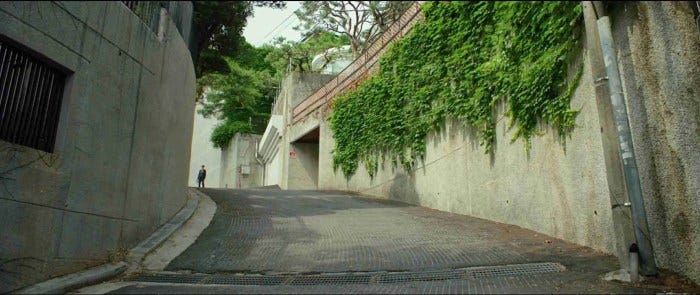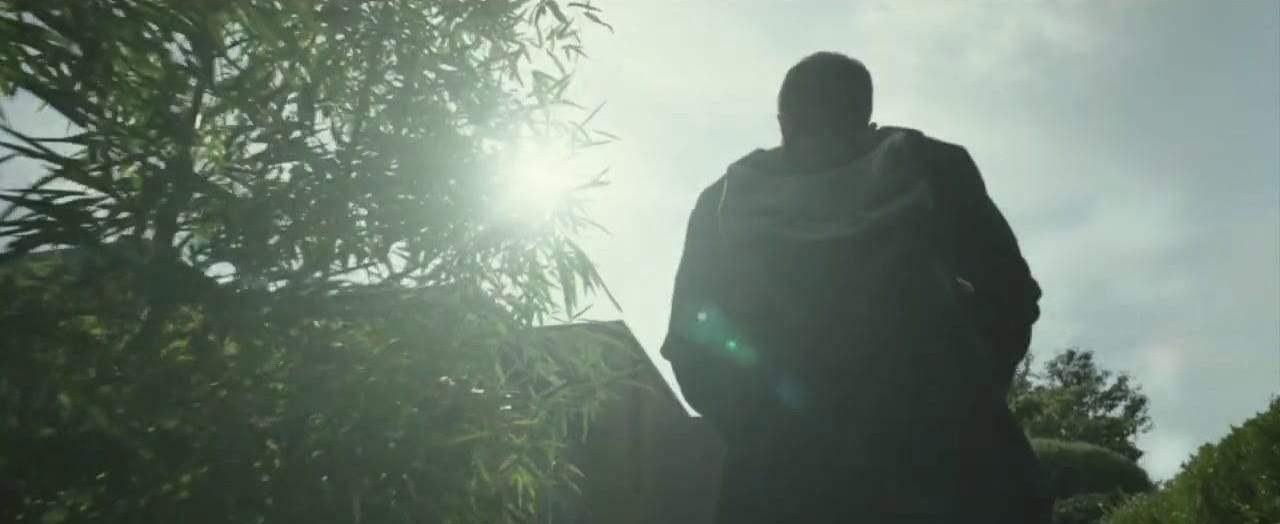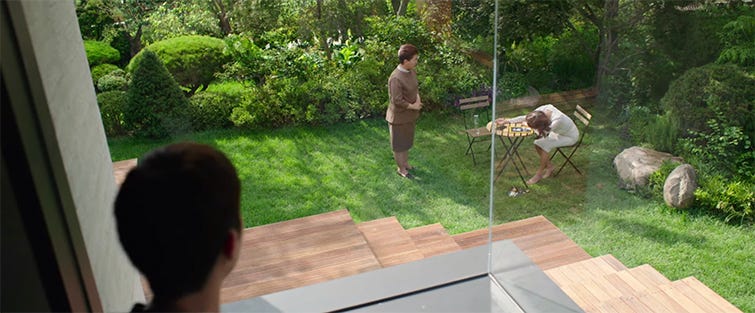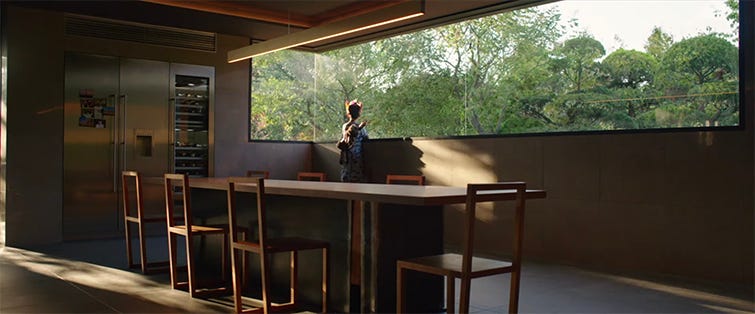A major theme from the 2019 film Parasite is plans. Our main character, the patriarch of the poor Kim family, refuses to make plans so as not to be disappointed when things go wrong. While this is key to the story, to the person telling it, director Bong Joon Ho, every detail and every frame are crucial. Each moment is meticulously crafted to make an airtight narrative.
In this essay, we will be discussing the way framing in Parasite directs the story––the subtle way details are revealed, dynamics are emphasized and themes are introduced.
The framing within Parasite inconspicuously communicates to audience who is who, and who belongs where. Ho begins asserting the position of the Kim family immediately with the opening frame of their semi-basement apartment window. Their window is the dark, grimy portal in which the Kim family see the world. This symbolically represents their apathy for the society that continually to disregards their existence. The world’s poor treatment of those at the bottom is emphasized by the position and view of the window: “they see cement street floors and various garbage, street cats, and the wheels of vehicles passing through their neighborhood…The eye level of this neighborhood means watching the densely-built houses of strangers, their lives, and even some of their private lives.”
The lack of privacy and chaos of the Kim home is juxtaposed by the stillness of the rich family’s neighborhood. The hillsides are full of citadel-like mansions, which Kevin would never know what happens inside. There are no passers-by or even a street cat. The riches’ privacy is keenly secured. Kevin’s position discomfort in this world and the power of the wealth that surrounds him is reinforced by his small position on the screen. He is merely a small spec among the towering mansions that surround him.
Framing reveals the dynamics between characters, especially through spatial composition and camera perspective. In one striking scene, the Kim family is crammed into the small bathroom of their semi-basement apartment, with the toilet and walls literally framing their bodies. This tight composition emphasizes their lack of personal space, confinement, and the inescapability of their socioeconomic condition. At the beginning of the film, the Kim family is also seen clustering around their boss in a narrow alleyway, squeezing into the frame one by one until they fully surround her. The shot keeps the boss centered while the Kims close in, united in movement and purpose—this composition subtly foreshadows their later infiltration of the Park household, always moving as a collective. Bong mirrors this visual unity in the basement shots, where the entire Kim family often shares the frame. In contrast, the Park family is frequently framed apart from one another, even within the same room. They are isolated in wide, clean spaces—visually disconnected, suggesting a lack of intimacy or cohesion. This contrast is genius in its simplicity; even if viewers don’t consciously register the framing, they feel its emotional effect.
Director Bong Joon Ho uses frames of the sets to emphasize elements such as stairs, railings and tile that create boundaries within the physical space the characters embody. In the Kim house, the characters are boxed in by shapes and lines, usually crouched into frame under an overhang or with clutter on either side of them. Even the son’s walk from the poor Kim house to the rich Park house begins with him squeezing out of the claustrophobic alleyway (again with its imposing concrete overhang) and then into the light, natural open spaces of the richer world (with trees being the only thing overhanging). The camera mirrors this, often looking down on the Kims early in the film, until the son Ki-woo becomes the Parks’ tutor—then, for a moment, the perspective shifts upward.
Glass acts as a metaphorical manifestation of the “line” which divides the rich and poor. For instance, in this scene, both Moon-gwang and Kevin, the Park’s housekeeper and tutor respectively, are on the left side of the line where the window panes converge and Mrs. Park is on the other side. When Moon-gwang quickly slaps Mrs. Park awake, she immediately returns to the left side of the line, only breaking society’s equilibrium for a moment. Bong Joon-ho’s use of clear but solid divides between his characters comes back around to Parasite’s main thesis – you might not think about class divides, you might not see them in your daily life, especially if your lifestyle is privileged, but those divides are there and they’re exceedingly difficult to crack, let alone shatter.
The original working title of Parasite was Decalcomania––a technique in which an image is created on paper and then folded over to form a doubled, almost symmetrical work of art. Many of Parasite’s shots function in the same way, being slightly off the perfect symmetry that appeases our minds. These shots were intentional; Bong wanted us to feel like we were almost getting somewhere and a sense that we’d never fully arrive. Perhaps Bong Joon-Ho is showing through his asymmetrical frames that these two families can never be the same, feel the same things, exist in the same microcosm – there will always be the smell that lingers – something to prevent the Kim’s from being part of the Park’s world. Perhaps he is showing that like with the Decalcomania, the picture is never truly symmetrical and life is no perfect fairytale.
Even with this sharp attention to visual structure, Bong Joon Ho never presents a simple binary of good and bad, victim and villain. The Park house, while luxurious, resembles an isolated castle: sterile, distant, and emotionally vacant. Meanwhile, the Kim family’s cluttered basement feels alive, albeit chaotic. Bong’s framing choices underscore this ambiguity, refusing to moralize either side. Instead, he shifts the focus toward the larger systems and structures––literally, the architecture—that trap his characters. The blocking reinforces this point: Mr. Kim crouched behind a bush in the final act, watching the Park family bask in the sun, is both literally and figuratively in the shadows. His marginalization is spatially expressed. When the Parks eventually move out, another wealthy family moves in, untouched by the chaos that upended so many lives. The Kims, however, remain in their semi-basement—framed once again by the window they began behind, a powerful return to the status quo. Ki-woo’s imagined ascent, framed as a dream sequence where he buys the Park house to free his father, plays on a familiar cinematic trope—gazing toward the horizon with hope. But this isn’t Star Wars; it’s Parasite, and Bong’s final frame quietly breaks that illusion. We are left not with resolution, but with haunting symmetry: a world where structures—both architectural and societal—remain unmoved, and those trapped beneath them remain unseen. Bong isn’t offering answers. He’s showing us that the problem isn’t who lives in the house, but the house itself. And the frame around it.
Link to video essay:
- Caroline
Further information:
https://medium.com/@syarifahhsn/architecture-motifs-in-parasite-af3244125627
https://www.thefilmagazine.com/windows-into-bongjoonho-parasite/ https://publicwebuploads.uwec.edu/documents/sam.pdf
https://www.indiewire.com/awards/industry/parasite-cinematographer-hong-kyung-pyo-1202189824/
https://www.filmmakersacademy.com/look-of-parasite/
https://colorculture.org/parasite-cinematography-analysis/
https://www.imaginated.com/photography/analysis/parasite/
https://photofocus.com/photography/analyzing-composition-lighting-and-color-in-parasite/










